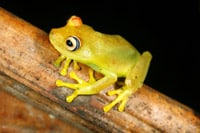This family of frog is important to understand amphibian diversity
|
|
For more than 200 years, the question of why there are more species in the tropics than elsewhere has been a biological enigma. A particularly perplexing aspect of this mystery is why so many species live together in a small area in the tropics, especially at some sites in the rainforests of the Amazon Basin in South America.
Recent research on the evolution and ecology of treefrogs has shed new light on the puzzle. The patterns found in treefrogs may also help to explain the relatively high number of species in the case of other groups of organisms – such as trees, birds and insects – which are present in the Amazon rainforest.
Amazing Biodiversity
“Treefrogs are a particularly important group to study for understanding amphibian diversity, because they can make up nearly half of all amphibian species in some rainforest sites,” explained lead author John J. Wiens, an associate professor in the Department of Ecology and Evolution at Stony Brook University in New York.
“This particular group of amphibians also offers a striking example of the high degree of biodiversity that exists at local level in the Amazon. At some sites in the Amazon rainforest, there are more treefrog species in a small area than there are to be found across all of North America or Europe.”
The researchers compiled data on the number of treefrog species at 123 sites around the world and analyzed the data with a new evolutionary tree (based on DNA sequence data) for 360 treefrog species. They found that the richness of treefrog species in the Amazon rainforest sites is not explained by wet, tropical climatic conditions alone.
“In fact, we found that many tropical rainforest sites that are outside the Amazon Basin have no more species than do some sites in temperate North America,” said Dr. Wiens.
Before Dinosaurs Died Out
Instead, the researchers discovered that the high biodiversity of Amazonian sites is related to different groups of treefrogs occurring together in the Amazon Basin for more than 60 million years – since before most dinosaurs became extinct. In contrast, those sites in tropical rainforests that have relatively few treefrog species are in areas that were colonized by treefrogs much more recently.
According to Dr. Wiens, these results also have important implications for humans. “The results suggest that the incredible biodiversity of amphibians in some sites in the Amazon Basin took more than 50 million years to develop,” he says. “If the Amazon rainforests are destroyed and the amphibian species are driven to extinction by human activities in the next few decades, it may take tens of millions of years for this incredible level of biodiversity to ever return.”
Reference
John J. Wiens, R. Alexander Pyron, Daniel S. Moen. Phylogenetic origins of local-scale diversity patterns and the causes of Amazonian megadiversity. Ecology Letters, 2011; DOI: 10.1111/j.1461-0248.2011.01625.x



